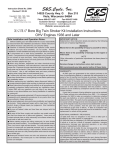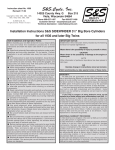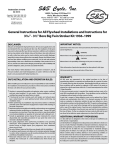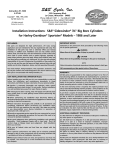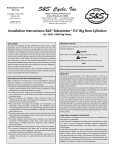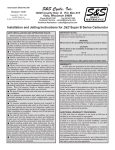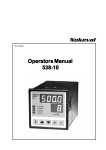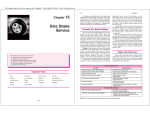Download S&S Cycle Motorcycle Accessories Service manual
Transcript
1 Instruction sheet No. 3000 Revised 4-6-99 S&S Cycle, Inc. Copyright ©, 1980, 1984, 1988, 1991, 1999 14025 County Hwy. G Box 215 Viola, Wisconsin 54664 by S&S Cycle, Inc. All rights reserved. Printed in the U.S.A. ® Phone 608-627-1497 Fax 608-627-1488 Customer Service - [email protected] Technical Assistance - [email protected] 3"/3-3/16" Bore Sportster Stroker Kit Installation Instructions OHV Engines 1957 and 1985 Safe Installation and Operation Rules: IMPORTANT NOTICE: Before installing your new S&S stroker kit it is your responsibility to read and follow the installation procedures in these instructions and follow the basic rules below for your personal safety. ● Gasoline is extremely flammable and explosive under certain conditions and toxic when breathed. Do not smoke. Perform installation in a well ventilated area away from open flames or sparks. ● If compressed air is used during installation, be particularly careful. Compressed air and particles dislodged from using compressed air are harmful to eyes and body. Wear protective goggles, and always direct air stream away from body parts such as hands and eyes and other people near you. ● When using solvents, degreasers and other chemicals during cleaning and installation, read manufacturer's instruction label for proper use. Exposure of some chemicals to skin, eyes and/or other body parts may be harmful. Many items are flammable and present a fire hazard. Use in well ventilated area and wear protective clothing when using them to avoid personal injury. ● If motorcycle has been running, wait until engine and exhaust pipes have cooled down to avoid getting burned before performing any installation steps. ● Before performing any installation steps disconnect battery to eliminate potential sparks while working on electrical components. ● Read instructions thoroughly and carefully so all procedures are completely understood before performing any installation steps. Contact S&S with any questions you may have if any steps are unclear or any abnormalities occur during installation or operation of motorcycle. ● Consult an appropriate authorized H-D service manual for correct disassembly and reassembly procedures for any parts other than those outlined in these instructions. ● Use good judgement when performing installation and operating motorcycle. Good judgement begins with a clear head. Don't let alcohol, drugs or fatigue impair your judgement. Start installation when you are fresh. ● Be sure all federal, state and local laws are obeyed with the installation. ● Be sure all fuel lines, supply and overflow, are routed correctly and fuel line clamps are in place and tightened. Lines must not contact exhaust pipes or other extremely hot surfaces where they could melt or leak and catch fire. ● Before starting engine and riding motorcycle, be sure throttle opens and closes smoothly. Turn handlebars to left and test throttle. Then, turn bars to right and test throttle. To avoid possible loss of control of motorcycle and potential personal injury to yourself or others due to throttle sticking in open position, throttle must work smoothly and return to a fully closed position when hand is removed from throttle grip. ● Motorcycle exhaust fumes are toxic and poisonous and must not be breathed. Run motorcycle in a well ventilated area where fumes can dissipate. Statements in this instruction sheet preceded by the following words are of special significance: WARNING Means there is the possibility of injury to yourself or others. CAUTION Means there is the possibility of damage to the engine or motorcycle. NOTE Other information of particular importance has been placed in italic type. S&S recommends you take special notice of these items. WARRANTY: All S&S parts are guaranteed to the original purchaser to be free of manufacturing defects in materials and workmanship for a period of six (6) months from the date of purchase. Merchandise that fails to conform to these conditions will be repaired or replaced at S&S’s option if the parts are returned to us by the purchaser within the 6 month warranty period or within 10 days thereafter. In the event warranty service is required, the original purchaser must call or write S&S immediately with the problem. Some problems can be rectified by a telephone call and need no further course of action. A part that is suspect of being defective must not be replaced by a Dealer without prior authorization from S&S. If it is deemed necessary for S&S to make an evaluation to determine whether the part was defective, a return authorization number must be obtained from S&S. The parts must be packaged properly so as to not cause further damage and be returned prepaid to S&S with a copy of the original invoice of purchase and a detailed letter outlining the nature of the problem, how the part was used and the circumstances at the time of failure. If after an evaluation has been made by S&S and the part was found to be defective, repair, replacement or refund will be granted. ADDITIONAL WARRANTY PROVISIONS: (1) S&S shall have no obligation in the event an S&S part is modified by any other person or organization. (2) S&S shall have no obligation if an S&S part becomes defective in whole or in part as a result of improper installation, improper maintenance, improper use, abnormal operation, or any other misuse or mistreatment of the S&S part. (3) S&S shall not be liable for any consequential or incidental damages resulting from the failure of an S&S part, the breach of any warranties,the failure to deliver, delay in delivery, delivery in non-conforming condition, or for any other breach of contract or duty between S&S and a customer. (4) S&S parts are designed exclusively for use in Harley-Davidson motorcycles. S&S shall have no warranty or liability obligation if an S&S part is used in any other application. 2 Installation of an S&S Sportster Stroker Kit is comparatively easy and can be performed by any average Harley-Davidson repair shop equipped to do complete engine overhauls. No special tools other than those used in normal overhaul operations are required. d ⁄16" Diameter hole 3 ⁄8" Line A 1 Read instructions thoroughly before starting work. When they are completely understood proceed with installation. Line B Installation Steps: 1. Crankcase Alignment & Cylinder Mounting Studs (All) 2. Lower Oil Return Holes (All) 3. Crankcase and Piston Skirt Clearancing (All) 4. Connecting Rod Preparation (All) 5. Lower End Assembly (All) 6. Connecting Rod Alignment (All)* 7. Breather Timing (All) 8. Piston to Valve Clearancing (All) 9. Final Top End Assembly and Engine Installation (All) 10. Timing, Carburetion, Exhaust, Gearing & Break-in (All) *NOTE - S&S recommends that engine builder consider performing some steps during initial engine disassembly. Breather timing check requires that most components be assembled, and performing check upon disassembly may save reassembly and cleaning time. While some or all related parts concerned in connecting rod alignment check may be replaced, it is helpful to check original parts combination and note discrepancies which may alter installation of new parts. ⁄16" Diameter hole 3 Line A ⁄8" 1 Figure 1 1. Crankcase Alignment and Cylinder Mounting Studs (All) NOTE - Some H-D crankcase base gasket surfaces on which cylinders are positioned do not align properly. This usually occurs when crankcase halves used are from different crankcase assemblies and were not paired and machined together at Harley-Davidson. It is recommended to check for crankcase misalignment even if crankcase halves are correctly matched to prevent potential oil leaks and other mechanical problems. CAUTION - Mismatched gasket surfaces due to improperly aligned crankcase halves may cause unwarranted stress on cylinder base flanges which could result in cylinder flange failure. A. Clean cases thoroughly and assemble both cases without flywheels and tighten all case bolts as in final assembly. B. Place straight edge across base gasket surface. See Picture 1. C. If any misalignment exists, remove cylinder base studs and place masking tape over cam and mainshaft bearings to keep chips out. D. Place cases squarely in mill and take minimum cut necessary to clean up. E. If stock cylinder studs are to be used, reinstall to original height. If studs are provided in kit, install to height that equals: thickness of cylinder base flange, plus base gasket, plus cylinder base plate, plus washers, plus base nut. Use Loctite Stud and Bearing Mount to secure studs. Picture 1 3 Centerpunch, then Centerpunch, then drill ⁄ hole " diameter hole drill 3⁄32" diameter 3 32 Figure 2 2. Lower Oil Return Holes Sportster cylinder oil return holes must be lowered in those stroker conversions where oil ring crosses stock oil return hole. This is necessary to prevent oil from returning above oil ring which will cause engine to smoke. Several lowering methods have been used successfully but rather than give them all, we decided to provide the one that requires the fewest special tools and materials. NOTES ● Oil rings will usually touch and/or cross oil return holes with installation of stroke 4 7⁄16” or longer. Strokes shorter than 4 7⁄16” do not require this step. ● Method given below was tried as an experiment when we installed an S&S 4 5⁄8” stroker kit in our 1972 test Sportster. All steps axcept 8 and 9 were performed. Picture 2 Object was to see if engine would smoke and use excessive oil which it did not. Several customers have also reported similar successes when leaving stock holes open. Based upon our test results and these customer reports, we feel relatively confident in recommending that stock oil return holes be left open even though we have tried it on only one test engine and cannot guarantee that it will work in all instances. If you decide to try leaving the stock oil return holes open, perform all of the following steps except 8 and 9. For strokes 4 7⁄16” and longer, perform following steps: A. Place cylinder with head gasket surface down on bench. Lay out lines “A” on cylinder base gasket surface so they are directly above centers of old oil return holes which exit into cylinder bore. See Figure 1. B. Lay piece of 1⁄8” thick material against cylinder spigot 90° to lines A and scribe lines "B". C. Centerpunch points where lines A and B intersect. D. Drill 3⁄ 16” diameter hole at each point perpendicular to gasket surface to meet passage coming from cylinder head. Be careful not to break drill when breaking into existing passage as holes may be slightly misaligned and drill may tend to grab. E. Centerpunch corners where lines A intersect spigot. See Figure 2. F. Drill 3⁄32” diameter hole at each point at 60° angle into cylinder bore. G. Enlarge 3⁄32” holes from inside cylinder bore with 3 ⁄16” diameter drill. H. Braze or weld old oil return holes shut. Picture 3 4 NOTE - Be sure person who does work knows how to work with cast iron as cylinders may crack or develop hard spots if not done properly Repeat step D to remove braze or welding material that may be obstructing oil return passages. J. Blow air through passages to remove chips, etc. B. Assemble pistons without rings on their proper connecting rods, and place connecting rods on crankpin. Installation of wristpin button is not necessary. I. CAUTION - Dirt, filings, etc. left in oil return passageways may circulate in oil damaging other parts possibly causing engine failure. WARNINGS ● Some solvents, degreasers, gasoline and other chemicals are harmful to skin, eyes and other body parts. Many items are flammable and present a fire hazard. Read manufacturer's instruction label for proper use. Use in well ventilated area and wear protective clothing when using them to avoid personal injury. ● Compressed air and particles dislodged by compressed air are harmful to eyes and body. Wear protective goggles when using compressed air and always direct air stream away from body parts such as hands and eyes and other people near you. 3. Crankcase and Piston Skirt Clearancing (All) NOTE - If pistons have piston to piston clearance notches ground on thrust face edges, place notches toward center of engine. Consult piston installation instructions included with pistons for proper piston direction placement. C. Install both cylinders and secure each with one nut. NOTE - If base plates are to be used, be sure they are in place. D. Rotate flywheel until rods contact areas to be clearanced. Note angle that must be filed. See Picture 4. E. Disassemble cylinder and connecting rods and file crankcase and cylinder spigot for clearance. NOTE - A minimum of 1⁄16” clearance is required. F. Reassemble and check clearance. G. This procedure must be done for both crankcase halves. Connecting Rod Clearance Pictures 2 and 3 show areas to be checked and/or clearanced for connecting rod to crankcase contact. Procedure to check these points is performed as follows: A. Mock up right side flywheel in crankcase half with mainshaft and crankpin installed with bearings, etc. in place. CAUTION - Insufficient clearance between connecting rods and crankcases will cause contact and damage to components. Picture 4 Picture 5 Piston Clearance Pistons must be clearanced to avoid contact with each other and with flywheels. See Pictures 5 and 6. 5 2.950 installed with larger intake pockets toward center of engine. Be sure to file material from skirt on intake side of piston. E. Reassemble and check clearance. Grind stroke clearance in this area Piston to Flywheel Clearance A. Perform steps A through C in "Connecting Rod Clearance" above. B. Rotate flywheel to position where front piston is closest to flywheel. See Picture 6. C. Check clearance between piston and flywheel. NOTE - A minimum of 1⁄16” clearance is required. Grind four oil grooves on both sides of forked rod Figure 3 Piston to Piston Clearance A. Perform steps A through C in "Connecting Rod Clearance" above. B. Rotate flywheel to position where pistons are closest to each other. See Picture 5. C. Check clearance between pistons. NOTE - A minimum of 1⁄16” clearance is required. D. Disassemble cylinders and pistons, and carefully file edge of piston skirts until clearance is obtained. Note - Intake valve pocket in piston dome are larger than exhaust valve pocket. Be sure pistions are Picture 6 D. Disassemble cylinder and piston, and carefully file piston skirt until clearance is obtained. E. Reassemble and check clearance. F. Repeat procedure for rear piston. NOTE - Material removed from pistons for clearancing purposes will not adversely affect flywheel balance. Some S&S kits utilize flywheels with diameters smaller than stock (stock Sportster flywheels are 7 7⁄8"). This is done to maximize piston skirt length. Our experience has shown that while it is better to build up flywheel scraper, it is not absolutley necessary. CAUTION - Insufficient clearance between pistons and pistons and flywheels will cause contact and damage to components. 4. Connecting Rod Preparation (All) NOTE - If S&S connecting rods are used, follow instructions that accompany rods since rod preparation below has already been done. If S&S rods are not used, perform following steps: A. To insure adequate oil on sides of rods and matching thrust surfaces of flywheels, S&S recommends that four grooves be ground on each side of both front and rear connecting rods. See Figure 3. Make these grooves .020" to .030" deep and .030" to .040" wide and should be ground 90° from each other. After making grooves, remove all sharp edges and burrs with emery cloth. B. With rods assembled, measure distance between rods at closest points in wristpin holes. If measurement exceeds 2.950" as shown in Figure 3, grind female rod at points where male rod makes contact to achieve sufficient clearance. 6 NOTE - Rods clearanced to this dimension provide adequate clearance for strokes up to and including 5". Do not remove any more material than is necessary to obtain required clearance. CAUTION - Inadequate clearance between rods or too much clearancing on rods will cause unwarranted stress on connecting rods, rod bearings, pistons, etc. resulting in possible failure of one or all aforementioned parts. C. Thoroughly clean all parts to remove dirt, filings, etc. CAUTION - Burrs, dirt, filings, etc. left on connecting rod components may circulate in oil damaging other parts possibly causing engine failure. Picture 7 5. Lower End Assembly (All) NOTES ● S&S Sportster flywheels with serial numbers that start with a letter or those numbered 1670 or higher are made from closed die, heat treated, steel forgings. They do not have connecting rod thrust washers like earlier S&S flywheels, because present flywheel material is harder than thrust washers previously used. ● S&S flywheels come with three timing marks. An "F” stamped by a mark means front cylinder, an "R” means rear cylinder and a “TF” means top dead center front cylinder. When front or rear mark is placed in center of timing hole it means that that cylinder is timed at 40° before top dead center. We recommend that stroker Sportster engines be timed at 40° initially. See Step 12, "Ignition Timing". ● Usually S&S flywheels are balanced before leaving our facility. Some customers prefer to do their own balancing or to have another balancing shop do the work for them. This is acceptable in most cases. However, we have had some bad experiences with dynamically balanced flywheels that have forced us to void our guarantee if flywheels have been balanced in this fashion. CAUTION - Flywheels assembled improperly prior to being dynamically balanced may sustain irreversible damage to mainshaft and crankpin tapers during actual balancing. S&S voids its guarantee if flywheels have been balanced in this fashion. ● Assembling flywheels, mainshafts and connecting rods can be easy or difficult. Degree of difficulty is determined by builder technique and parts at his disposal. While S&S flywheels have been noted for their easy truing qualities, they can be difficult to true if a defective part is used that should have been detected before assembly. ● Cleaning parts prior to and during assembly and keeping parts clean after final assembly is imperative to minimize contaminants that may circulate in oil and shorten engine life. Use cleaning agents that do not leave harmful residues, and be sure to read and follow manufacturer's instruction label before use. Use drills and compressed air to clean all oil passageways of dirt, filings, etc. whenever possible. WARNINGS ● Some solvents, degreasers, gasoline and other chemicals are harmful to skin, eyes and other body parts. Many items are flammable and present a fire hazard. Read manufacturer's instruction label for proper use. Use in well ventilated area and wear protective clothing when using them to avoid personal injury. ● Compressed air and particles dislodged by compressed air are harmful to eyes and body. Wear protective goggles when using compressed air and always direct air stream away from body parts such as hands and eyes and other people near you. Perform following steps when assembling flywheels: A. Thoroughly clean all parts to be used. This includes mainshafts, main bearings, connecting rods, rod bearings, crankpin nut retainers and screws if they are to be used, keys and flywheels including tapers and keyways. 7 CAUTION - Burrs, dirt, filings, etc. left on flywheel assembly parts may circulate in oil damaging other parts possibly causing engine failure. NOTE - S&S recommends to tighten nuts very tight. We use a 3⁄4”drive breaker bar and a five foot piece of pipe when assembling flywheels. B. Check both mainshafts between centers for taper surface to bearing surface concentricity. Make sure centers on shafts are clean beforehand. If tapers and bearing surfaces are concentric with each other and with center, then truing will be easier. See Picture 7. After right side flywheel, pinion shaft and crankpin are assembled, blow air through pinion shaft oil feed hole to check for blockage. NOTE - Current H-D specs. allow maximum of .001" runout between taper and bearing surfaces. We feel this is too much and prefer to see .0003" or less with an absolute maximum of .0005". S&S shafts are .0003" or less. C. Inspect keyways and oil holes for burrs in flywheels and remove if necessary. D. With key in shaft, insert into respective tapered hole in flywheel and check to see that key does not bottom in groove. If key bottoms out, file flat side of key, not rounded side, until shaft with key in place fits in flywheel without bottoming out. Check crankpin and crankpin key also. E. Reclean mainshaft tapers, crankpin and flywheel tapers with lacquer thinner. F. Assemble mainshafts in respective flywheels. Coat taper and threads of each shaft with green Loctite RC 609 or Omni Fit 1730 during assembly. Install crankpin in camside flywheel using Loctite also. Tighten all nuts to at least factory torque specs minimum. When S&S shafts are used, follow instructions included with them. Picture 8 CAUTION - Partially or completely blocked oil feed passageways may cause irreversible damage to bearings and other engine components. G. Measure width of female rod on crankpin end. See Picture 8. Measurement should be 1.481” to 1.483". H. Assemble left and right flywheels and moderately snug nuts. Do not worry about them being true. Measure distance between connecting rod thrust pads. See Picture 9. NOTE - S&S recommended rod side play is .015" to .035". Rod Side Play Equals (Distance from Pad to Pad) - (Female Rod Width) CAUTION - Incorrect connecting rod side play may cause excessive rod side thrusting and potential damage to rods, flywheels and other engine components. If difference is less than .020", female rod must be ground on sides as final tightening will pull wheels closer together. Rod side play diminishes about .015" when crankpin nut is final tightened. Take equal amounts off each side if amount to be removed is more than .010". Picture 9 8 If there is no rod side play try different crankpin. If rod side play is more than .035", try different crankpin. We have run side play of as much as .045" without serious consequences. If side play is excessive and different crankpins do not correct problem, contact us. NOTE - If material is removed from sides of female rod, overall width of bearing cages must be reduced so bearings and cages are free to float with rods without contacting flywheel thrust pads. Bearing cage side clearance of .008 to .020 less than rod width is recommended. CAUTION - Connecting rod bearing and cage assemblies that are wider than female rod may become damaged upon contact with flywheel thrust pads. Damaged rod bearing assemblies and/or foreign material from damaged components circulating in oil could cause further destruction and possible failure of other engine parts. I. Finish assembling flywheels and rods. Following above procedures will help diagnose problem if difficulty should arise. 6. Connecting Rod Alignment (All) After flywheel assembly is installed in crankcases, rods must checked for straightness. S&S Rod Checking Pin, Part #53-0002, was designed to help perform this procedure. It may also be necessary, to fabricate a rod bending tool as illustrated in Figure 4. NOTE - The purpose of this procedure is to correct for machining tolerance discrepancies in components which may lead to pistons not running true in cylinder .510"-.520" Wide Slot 1 1/8" 4" 22" 1 1/4 " Figure 4 Picture 10 bores. While rods may be straight and true, it is sometimes necessary, to bend them to correct for these machining discrepancies. Do not bend rod by using tool in wristpin hole as this method may distort wristpin bushing. We also feel that using a piston in lieu of a checking pin may prove inaccurate due to variations in lengths of piston skirts from one side of piston to the other. CAUTION - Pistons which do not run true in cylinder bores may cause excessive connecting rod side thrusting. This in turn may lead to premature ring, piston, connecting rod and rod bearing wear and eventual failure of these parts. Checking Pin Procedure A. Insert checking pin into wristpin hole. Place strips of paper between checking pin and crankcase cylinder gasket surface and apply slight downward pressure to wristpin end of rod by rotating flywheels. Pull papers out slowly. Drag on papers should be equal. B. Rotate flywheels in opposite direction until checking pin contacts cylinder gasket surface again. Repeat procedure to rod again. If drag on papers is equal no bending is required. If one paper is loose, use rod bending tool to tweak rod in direction of loose paper and recheck. See Picture 10. C. Repeat checking and bending procedure for other rod. Visual Procedure A. Install pistons on rods without rings or wristpin buttons. Bolt cylinders with gaskets in place. 9 B. Move piston tight towards camside of engine. C. Turn engine over in normal direction of travel 2 or 3 revolutions and observe piston during process. D. Move piston towards driveside of engine and repeat Step C. If inaccuracies are present due to machining variations in cases, cylinders or pistons, top land of piston deck will appear closer to cylinder wall at one point around circumference. This means that piston is cocked in cylinder bore and can be corrected by bending rod in opposite direction. Figure 5 shows an exaggerated side view of this condition. E. Repeat Steps B to D for other cylinder. NOTE - All engines should be checked upon disassembly for incorrect piston alignment. This applies to those which are receiving new pistons as well as those being completely rebuilt. Observe pistons for wear spots on sides above top compression ring. If one side near wristpin is worn clean while side opposite is carboned up, then piston was not running straight and true in cylinder bore. Piston will also generally show diagonal wear pattern on thrust faces of skirts and possibly signs of connecting rod to wristpin boss contact inside piston. We feel that not enough emphasis is given to checking piston alignment in cylinder bore. Proper piston alignment means connecting rods will thrust to sides less minimizing added stress on pistons, rings, rod bearings and other related parts. 7. Breather Timing (1957 to 1976) NOTES ● Instances of smoking in early Sportsters led us to believe that crankcase breather timing was incorrect. Examination of several engines has shown that breather timing varies from engine to engine because of differences in overall width of crank assembly which changes position of pump drive worm gear on pinion shaft with respect to pump gear. When engine is disassembled, breather timing should be checked and set to XLR specifications. ● Breather timing should be set so breather valve opens when front piston is at 20° to 25° after top center (ATC) position, and closes when front piston is at 85° to 90° after bottom center (ABC) position. ● Crankcase oil scavenging can be greatly improved on 1957 to 1971 engines by converting to 1972 and later style breather parts combination. If your engine is 1971 or earlier, we strongly recommend purchase of 1972 and later pump breather gear, H-D part #26331-72 and corresponding gear retainer lock ring, H-D part #11002. These parts are used in place of early pump breather gear, part #26331-60, because slot in early version is too wide and requires the removal of too much material from pump body to achieve desired results. When later parts are used in early pump, scavenger gear, part #26315-62, must be installed with flat side of gear facing retainer lock ring. To check and correct crankcase breather timing, perform following steps: A. Before installing oil pump, turn pump gear counterclockwise until sleeve hole in gear aligns with slot in pump body. Place .002" shim in opening and reverse gear until tight. Scribe mark across pump gear sleeve and pump body at small timing notch on top edge of body. See Figure 6. Scribe mark Breather gear just starting to open Enlarge closing side only Figure 5 Figure 6 10 NOTE - Pump gear sleeve is very hard and scribing mark may be difficult. It may be advantageous to coat top ring of sleeve just below teeth with Dykem Blue to make marking easier. B. Install and time pump in normal manner as in final assembly. C. Install degree wheel on sprocket shaft, and position pointer at 0° when front piston is at top dead center (TDC) position. D. Rotate front piston to 25° ATC. Be sure oil pump drive gear is firmly butted against shoulder on pinion shaft. E. If scribe mark on pump gear is to left of scribe mark on body, grind material off engine side of pump drive gear to allow it to move farther onto shaft until scribe marks line up. If scribe mark is to right, place shim between pump drive gear and pinion shaft shoulder to line up marks. Big Twin cam thrust washers, H-D part #25550-36, can be used for this purpose, but are marginal because they fit pinion shaft poorly. For a better fit we fabricate our own washers to exact size. F. Rotate crankshaft so front piston is at 85° ABC (after bottom center). G. Make a second scribe mark on pump to align with first scribe mark on body. H. Remove pump and carefully grind or file slot wider in body towards cam cover until it closes at second scribe mark. Proceed with caution. Do not remove more material,than absolutely necessary. If unsure, contact S&S before you make a mistake. CAUTION - Improper breather timing causes poor oil scavenging from flywheel cavity and incorrect crankcase air pressure. These conditions may cause unwarranted engine oil leaks around gaskets and seals and probable oil burning due to oil blow by past piston rings. Removal of excessive material from slot opening is irreversible and damage to body may result. I. During final assembly, place oil pump drive gear on pinion shaft, and time pump in normal fashion. If material was removed from flywheel side of oil pump drive gear, it may be necessary to shim between pump drive gear and pinion gear. NOTE - Pinion gear must be flush with or extend out slightly past splines on pinion shaft so pinion gear end play shim does not contact pinion shaft splines instead of pinion gear. CAUTIONS ● Improper pinion gear spacing may cause incorrect breather timing and poor oil scavenging from flywheel cavity. This condition may cause unwarranted engine oil leaks around gaskets and seals and probable oil burning due to oil blow by past piston rings. ● Improper pinion gear spacing may cause unwarranted contact between pinion gear shim and pinion shaft splines resulting in damage to gear cover and/or other engine components. J. Check clearance between pinion gear and cam cover bushing. Recommended clearance is .005". Place shim between pinion gear and gear cover. H-D shims, part #18268-48, are .015" thick each and may be used for this purpose. 8. Piston to Valve Clearancing (All) NOTE - All valve spring spacing, rocker arm to collar and rocker arm to rocker cover clearancing must be done before piston to valve clearancing can be checked. S&S pistons have sufficient valve clearance when used with most street high performance cams. However, we recommend that valve clearancing be checked if other than stock cam is used. Check piston to valve clearance in following manner: A. Assemble engine with exception of cylinder heads. Be sure valve pockets are positioned correctly. Note - Larger intake pocket must be toward center of engine. B. Turn engine over until front piston is at top dead center. Paint area around valve pockets on pistons with machinist's blue. C. Place valves in cylinder head leaving off springs and retainers. Place head on cylinder and secure with one bolt. D. Lower valves until they contact piston. Rotate valve marking painted area. E. Remove head and check points of contact. Valve should fit in recessed area machined in piston dome. NOTE - S&S recommends at least .060" clearance around periphery of valve. 11 F. If insufficient clearance exists, remove piston and grind valve pocket until head of valve fits flush with proper clearance. G. Repeat procedure for other cylinder head. H. Spread layer of putty into valve pockets in both pistons. I. Assemble cylinder heads and bolt assemblies on cylinders with head gaskets in place. Install pushrods and adjust to simulate final assembly. J. Turn engine over in normal direction of travel two complete revolutions. K. Disassemble engine and check thickness of putty in valve pockets. NOTE - S&S recommends at least .060" clearance between valve and piston valve pocket recess. While .060 clearance is recommended minimum, it is advisable to have .080 and up, if possible. CAUTION - Insufficient clearance between piston and valves may cause them to contact each other during operation resulting in damage to piston and valve train components. L. If less than .060 clearance in any area exists, grind area until proper clearance is achieved. 9. Final Top End Assembly and Engine Installation NOTE - All previous steps must be completed. We recommend installing cylinders without heads bolted to cylinders for two reasons. 1. Combined weight of cylinder and cylinder head makes assembly cumbersome and hard to handle during installation. 2. Separate installation of cylinders and cylinderheads permits more leeway for adjustment to achieve a better manifold fit. CAUTION - Installation of cylinders and cylinder heads as assemblies may result in damage to rings and piston assemblies. Improper intake manifold fit may cause intake air leaks/improper fuel mixture and resultant damage to engine components. Final Assembly A. Install and tighten cylinders, cylinder heads and manifold as in standard assembly. NOTE - Retighten cylinder base nuts and head bolts as necessary after engine has been run. B. Install engine in frame. C. Install engine head mount. NOTE - Stock head mount will be short if you are installing S&S stroker kit with cylinder base plates. If 1 ⁄16” thick or less plates are used, modify stock mount. If plates thicker than 1⁄16” are used, install S&S extra long head mount. 12. Timing, Carburetion, Exhaust, Gearing & Breakin (All) Ignition Timing Notes ● See Step 5, "Lower End Assembly", for explanation of S&S timing marks. ● S&S flywheels have timing marks that position pistons at 40° before top center, same as stock, when mark is in center of timing hole. Placing mark to right side of hole or just entering hole advances timing almost 5°. Vice versa, if mark is just leaving hole, timing is retarded almost 5°. ● Set ignition timing on all engines at 40°. On engines equipped with vacuum operated advance mechanism, set timing using Factory procedures. ● Ignition timing for engines with dual plugged heads should generally be retarded 5-8° from the stock setting. However, due to the large number of factors involved, optimum ignition timing is impossible to accurately predict and must be determined for each engine by experimentation. CAUTION - Improper ignition timing may cause excessive engine heat which may damage pistons and/or other engine components. Carburetion Notes ● All S&S test engines have been run with S&S carburetors. A Super E or Super G carburetor is recommended for most strokers. Consult carburetor jetting instructions for specific jetting recommendations. ● If another type carburetor is used, it must be made to run rich enough so engine is not damaged. Other carburetor types are a personal problem and we cannot answer questions concerning them. It is best to call carb manufacturer if you have any questions. Exhaust Systems Notes ● To establish performance guidelines, S&S used 30” long stock diameter drag pipes with good results. We suggest you try them on these engines to establish a baseline to compare with other systems. ● You might ask the manufacturer of the exhaust system you are considering if he has had any experience with S&S strokers. Many systems are made 12 for looks with little consideration given to performance. Most stock systems and many aftermarket ones tried are too restrictive for good performance. HarleyDavidson does offer a series of mufflers that can be used with stock header pipes. These work very well in most situations and offer an inexpensive alternative to a new exhaust system. We prefer their tapered and baloney cut styles. Gearing Note ● Gearing depends on total weight of machine and rider/s, size of engine, caming, exhaust system and type of riding to be done. Most strokers are capable of pulling more gear. We suggest you break engine in with stock gearing to minimize lugging engine. After engine is broken in you will have a better feel of its potential and can change gearing accordingly. ● For those who wish to determine their final drive gear ratio the formula is as follows: Engine Revolutions Per One Revolution of Rear Wheel = (Clutch sprocket*) x (Rear Wheel Sprocket*) (Motor Sprocket* x (Transmission Sprocket*) * Number of teeth on each sprocket Break-In Procedure CAUTION - Lugging or running engine prematurely at high rpms may result in damage to pistons and/ or other engine components. S&S voids its guarantee if engine is not broken in properly. Break engine in using following procedure: A. On initial engine startup, don’t just sit and idle motor while you admire your work, or tinker with minor adjustments. Heat buildup can be excessive. B. First 50 miles are most critical for new rings and piston break-in. Most engine damage will initially occur during this period. Keep heat down by not exceeding 2500 rpm. Vary speed. Do not lug engine. C. Next 500 miles should be spent running engine no faster than 3500 rpm or about 50-55 mph. Do not lug engine and continue to vary speed. D. For balance of first 1000 miles, speed can be run up to 60 to 70. Continue to run engine at all different speeds including lower 40-45 mph ranges. E. 1000 to 2000 miles—basically same procedures as before. You can be a little more liberal with rpm range. Avoid overheating engine and putting any hard strain on it (drag racing, trailer towing, sidecar operation). F. 2000 miles and up—have fun! NOTE - These engines must be broken in. They will feel extremely strong, but resist the impulse to turn it on. Break it in properly. STROKER POWER!












